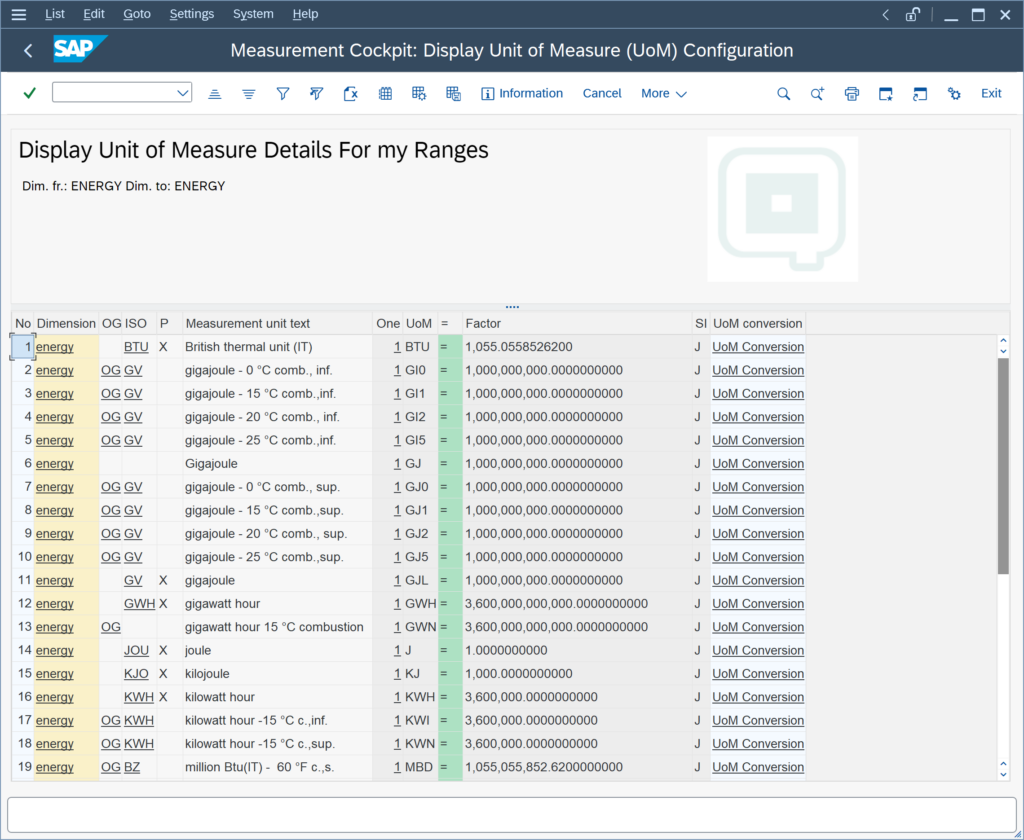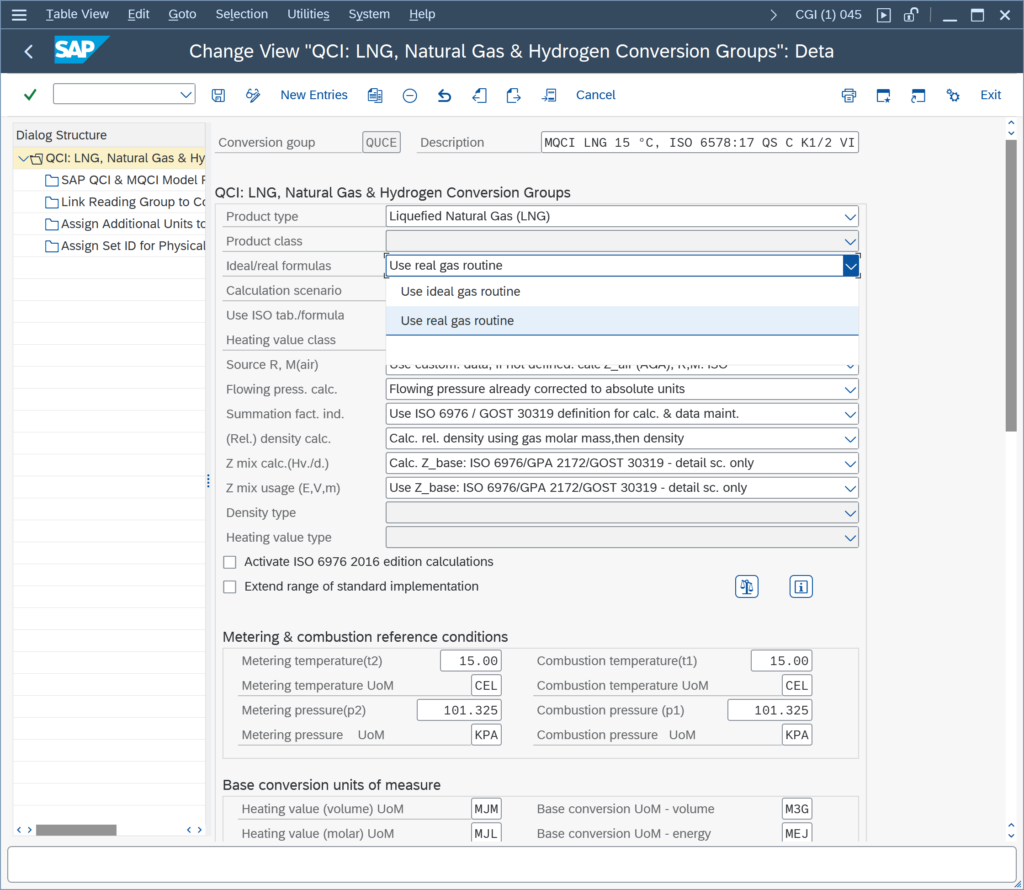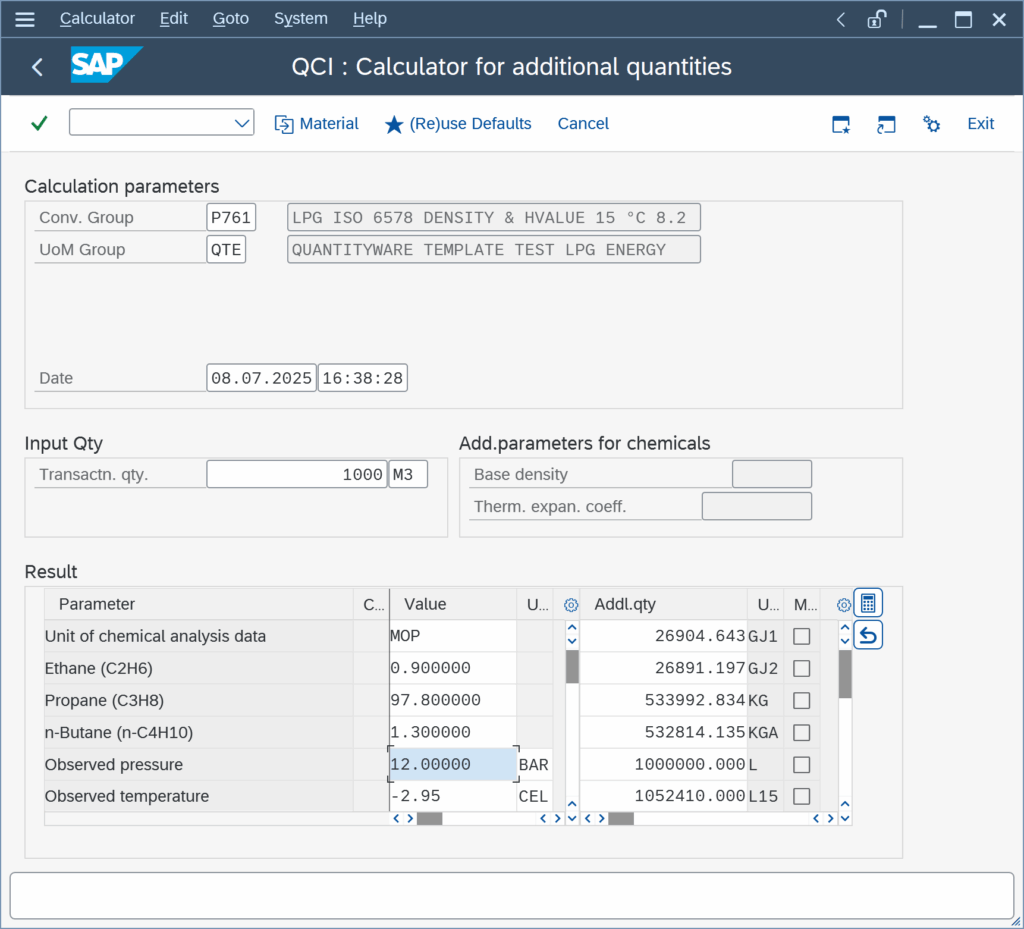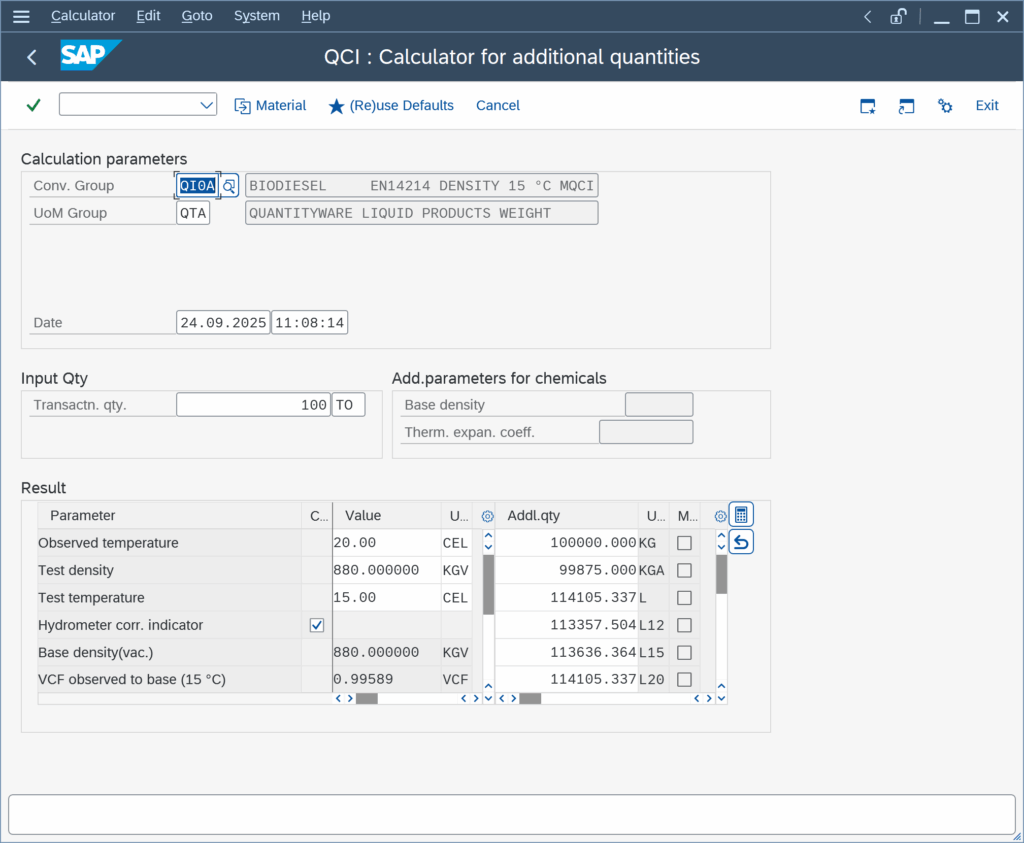BCG Configuration FAQs
Answers to common questions regarding configuring Bulk Calculations – Gas (BCG) on your systems
Which conversion group should I use for my high pressure pipeline natural gas project?
For high pressure natural gas projects, an MQCI conversion group should be selected. A certified BCG consultant can access the Gas Measurement Cockpit (GMC) and will follow the PAIG Methodology in order to create a selection of template conversion groups. The correct choice then depends on the detailed calculation scenario requirements which you will discuss with the certified consultant.
Example:
Template selection of high pressure conversion groups for AGA Report No. 8 / ISO 6976 calculations:

Does QuantityWare BCG support hydrogen quantity conversions?
Yes.
Due to strong industry demand, QuantityWare has defined a development & delivery strategy for 100% hydrogen quantity conversions, which is published in note 000106. Read the BCS Supported Products Manual for this new product support.
Read the FAQ for natural gas / hydrogen mixtures for support of natural gas – hydrogen mixtures, which are also supported.
High Pressure Solution:
The first release of a 100% high pressure hydrogen quantity conversion solution – as part of QuantityWare BCG 3.0 –
We are processing natural gas with a high hydrogen fraction, but not 100% hydrogen. What conversion groups can we use for such a gas?
As stated in the research paper from the DVGW: “Calculation of Compression Factors and Gas Law Deviation Factors Using the Modified SGERG-Equation SGERG-mod-H2”
“The AGA8 equation and the GERG-2008 equation generally agree better than ± 0.1% for the measured values for all data sets in the entire pressure range. It can thus be expected that these equations of state can be used for any desired H2 fractions without significantly affecting the underlying 0.1% uncertainty of the equations.”
Thus, BCG conversion groups that are configured to utilize AGA8 compression factor calculations may be utilized for natural gas / hydrogen mixtures of any ratio.
We receive error message /QTYW/BCG032 "Sum of mole fractions is not unity to the nearest 0.000 1, variance is 0.001", why is that?
Issue:
You attempt to perform a quantity conversion for natural gas where the molar composition of the natural gas needs be entered. This composition needs to be complete and the sum of all mole fractions needs to be 1 +/- 0.000 1, as specified in the relevant natural gas measurement standards. This is not the case.
System Response:
The system stops processing.
QuantityWare BCG implementations for natural gas, LNG or NLG/LPG, where the chemical composition is entered for property calculations, require that the chemical composition data is normalized such that the sum of all fractions is within 1 +/- 0.000 1 mole.
What UoM are supported for natural gas and LNG calculations?
QuantityWare BCG supports all UoM of the following SAP dimensions:

In general, any UoM that is defined with an established UoM conversion factor to the SI UoM of that dimension may be utilized / defined.
I require UoM gigawatt hours for my natural gas reporting, how do I define it?
Gigawatt hour is an energy UoM. As part of the QuantityWare configuration template (BC sets), 35 energy UoM are delivered:


Gigawatt hour and terawatt hour are defined in the current BCP and BCG template.
Creating a new energy UoM
If you have not installed BCS 30A CSP-003 / BCS 30B CSP-002 , a new energy UoM can be added easily to the template and then distributed through your system landscape. Copy e.g. UoM MWH (megawatt hour):

to GWH and TWH,
Which conversion group should I use for my LNG project?
For LNG projects, an MQCI conversion group should be selected. A certified BCG consultant can access the Gas Measurement Cockpit (GMC) and will follow the PAIG Methodology in order to create a selection of template conversion groups. The correct choice then depends on the detailed calculation scenario requirements which you will discuss with the certified consultant.
Example:
Template selection of LNG conversion groups for detailed ISO 6578 LNG calculations:

What is the difference between the ideal and real gas law?
THe difference between ideal gas and real gas is explained in the QuantityWare BCG Documentation Reference Manual, Chapter 9.2.
QuantityWare BCG supports both ideal gas and real gas calculations:

What options do we have for ISO 6578 LNG density calculations from composition?
QuantityWare BCG supports the ISO 6578 (Version 1991, 2017 and 2025) density calculations for LNG. As described in Note 000076, the main difference between these versions is the definition of configuration data, i.e. the k1 and k2 factors and orthobaric molar volumes. Customers may wish to utilize their own, contractually defined, calculation data sets.
NOTE: This is a critical task for any LNG implementation, thus a certified BCG consultant is required to support this task.
You have three options to define the density calculations:

- Utilize ISO 6578:1991 data –
My LNG volumes in SAP Tank Management are way to large, how can this be?
As capacity UoM, the tank master data in SAP Tank Management (transaction O4NA) requires usage of a UoM of dimension VOLUME.
Consequently, you have defined e.g. M3 (cubic meter, m³) as capacity UoM.
Issue:
You maintain a tank dip, utilizing your strapping data values in M3; the mass and energy quantity values calculated by the system appear to be too small when compared with the apparent liquid LNG M3 value calculated from strapping – or, vice versa, the volume quantity value in M3 (or any other UoM of dimension VOLUME) appears to be too large in relation to the mass and energy quantity values.
Why are there no chemical components for i-butane and i-pentane defined in the gas component analysis?
You enter the chemical composition data for a material or conversion group into the gas component analysis. However, there are no fields for i-butane (isobutane) and i-pentane (isopentane). Why?

i-butane and i-pentane are synonyms for the components 2-methylpropane and 2-methylbutane (the preferred IUPAC name), i.e. i-butane is 2-methylpropane and i-pentane is 2-methylbutane.
Some template conversion groups contain this mapping in the reading group parameter description, e.g. QVK0:

We enter pressure values for gas calculations. Are these values absolute or gauge pressure values?
QuantityWare BCS implementations for LPG/NGL, LNG and natural gas support both the data entry of absolute or gauge pressure values. Crude oil and products CPL calculations do require entry of gauge pressure values.
The conversion group configuration for LPG/NGL, LNG , natural gas, crude oil and products can thus be made to support data entry of either gauge or absolute pressure values – by adding or removing dedicated MQCI pressure calculation functions to the conversion group function module sequence.
I enter a vapor pressure value in bar, and it is converted to the value in kPa, why is that?
For pressure value data it is important to differentiate between absolute pressure values and gauge pressure values.
For all conversion groups, that are configured to require entry of pressure values, these values can either be a gauge or an absolute pressure value.
The behavior described in this FAQ question is defined within dedicated MQCI pressure conversion functions, that convert gauge pressure values to absolute pressure values – visible to the user and using the base pressure UoM as absolute (or vice versa).
If you do not require this behavior, you may replace the MQCI pressure conversion function with the corresponding function that treats all UoM as either all absolute or all gauge values,
We receive error message /QTYW/BCG 114 - Heating value class is initial. How can we resolve this issue?
Issue:
You perform quantity conversion calculations utilizing MQCI natural gas or LNG conversion groups. You receive error message /QTYW/BCG 114 – Heating value class is initial, enter a valid heating value class.
This message does not explain why the calculation is not completing. It actually appears, if the transaction UoM or any target UoM is not of an allowed SAP dimension ID – Energy, Volume, Mass (or Volume(Liquid, LNG)) for LNG and natural gas.
Example – Test calculation for high pressure natural gas:

The calculation is executed successfully.
Can we have one LPG/NGL conversion group, that either performs a static vapor space tank dip calculation or a CPL&CTL dynamic calculation for pipeline LPG?
Yes.
This is in principle possible.
Example:
Let’s copy template conversion group Q761 to P761:
- Add the material/observed pressure parameter to your reading group
- Activate the dynamic pressure calculation for your copied conversion goup
Pipeline flow calculation with observed/ flowing pressure of 12 bar:

Note:
The CPL is calculated internally, and multiplied with the CTL to obtain a CTPL. The CTL and CPL are not displayed separately in standard BCP configurations.
I have set my quantity value UoM L15 and L20 to be rounded to zero decimals, but it is not working. What can I do?
The UoM real rounding settings for the final target quantity values are considered for all MQCI template conversion groups. where the required rounding function is assigned. Ensure that rounding function
/QTYW/MQCI_ROUND_ALT_QUANTITYis assigned to your conversion group. Example: QI0A


To define and activate the real rounding for a UoM, go to the PMC or GMC and navigate to: ( More -> ) Goto -> UoM Rounding:

Enter the UoM for which you require final quantity value rounding:

Maintain the number of decimals for each UoM that shall be rounded –
How can I extend the density and temperature range for my product?
Issue:
You trade a product which has a base density beyond the supported measurement standard range; or, temperature values along your supply chain are beyond the measurement standard range limits.
Solution:
It is possible to extend the calculation range with one click in the conversion group configuration:
You simply extend the range for densities, pressures and temperatures by selecting the “Extend range of standard implementation” indicator in the conversion group details screen:

This is possible for QuantityWare BCP ASTM D1250-80 and ASTM D1250-04 implementations,
What is MQCI function /QTYW/MQCI_SYNC_EXT_VALUES good for?
All QuantityWare MQCI template conversion groups are configured such that the MQCI function module sequence contains function
- /QTYW/MQCI_SYNC_EXT_VALUES
as default.
This function detects quantity value data that is passed from external systems (e.g. TAS systems) and subsequently synchronizes dependent quantity values based on that data.
If required, this synchronization may also be implemented for SAP QCI conversion groups via SAP QCI BAdI implementations at your own risk. Such a task should only be performed by a certified BCP consultant that is assigned to your implementation or renovation project.



